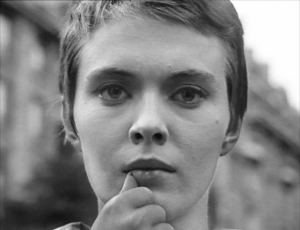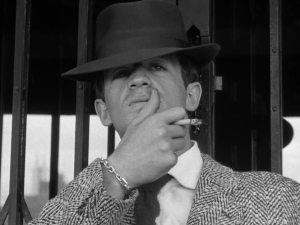Last Two Saturdays ago, the rainy day was a bit distracting. To cure it, the best bet seemed to go see a movie. The Landmark Theatre had kicked off its summer classic film series, and seeing a flick in an actual theatre was more than fitting, and it could not be resisted.
Running into fellow improvisers, Stef and Matt, well, validated my decision and the ability to choose wisely. It’s reassuring to have those little nuggets of reassurance now and again (but not to the point where you’re spoiled and become dependent).
Breathless is a 1960s French film by Jean-Luc Godard. Petty thief and antagonist, Michel, is the Humphrey Bogart-obsessed character I grew to love and despise. After a rash decision to kill a police officer, he finds himself on the run and dealing with the trickling in of public, media clues that he’s a wanted man.
The writing was very well done to generate those feelings, and actor Jean-Paul Belmondo played the role fittingly and with a cigarette hanging out of his seemingly blistered lips the entire time. The cigarettes are thick and obtrusive, but they look flimsy aside staying balanced.
When the cigarette is out of his mouth, Belmondo’s Michel runs his thumb back-and-forth over his closed lips. He clearly does this in times of critical thinking, when he is surveying the area or thinking of a person. In the latter case: Patricia (played by Jean Seberg) ends the movie with the same gesture, as if there was some understanding and melancholy after … Well, there will be no spoilers.
Technically, because of her actions — in light, she did the right thing — and the conclusion proves that Michel would do anything for her, save the fact that he was at fault.
At the same time, there is a reasoning for Michel’s actions as he is a fan of Humphrey Bogart. Where his standing in front of a movie poster for The Harder They Fall may foreshadow the conclusion, the admirable antagonist constantly imitates the movie star.
In Scrubs, Dr. Perry Cox, played by John C. McGinley, has a habit of touching his nose and then crossing his arms. I forget which season it is, McGinley explains in the behind-the-scenes segment that he developed the habit for his character after Paul Newman’s Henry Gondorff in The Sting.
It’s the go-ahead sign that Gondroff shows, saying that everything is right on target — on the nose? — or that the “con is on.”
Cox uses it a little differently, almost as a preemptive notion to let J.D. or any of the other characters that he’s listening and understanding, an “OK, go on.” But that nose touch could precede an infamous Coxian rant and a forehead vein bulge or the seldom blatant reassurance that he gets whatever is going on in the scene.
Even in the movie Face Off, Travolta’s character touches/caresses the face of his son and loved ones. But that gesture of endearment is what it is. It’s as tactful and clear-cut as John Belushi’s zit routine in Animal House or Michael Keaton’s crotch grab in Beetlejuice.
And then there is Colin Farrell’s character, Ray, in In Bruges. He quite often touches his face with his fingers, moving the skin around his mouth and jaw. The in-pain hit man shows his vulnerability, adding to the fact that he’s not cut out for the life of a professional killer.
His two extremes of defense mode emphasize innocence and quick to retaliate. He cannot come to terms with the accident at the beginning of the film, and when it comes to matters of the heart — love. There is a clear understanding of his knowing the difference of right and wrong.
He’s a natural on and off the job. Could Ray’s character be the perfect human being? Might be a stretch to say, but it’s entertaining to consider.
I have tendencies to touch my face, my mouth — “pull a Ray” (for lack of a better phrase). I’ll also rub my fingers in times of nervousness, or break eye contact. Sometimes I’ll contemplate shaving later that day.
In times of admiration, my hands will make their way into trouser or jean back pockets.
As for others, sometimes it’s difficult to tell nerves from satisfaction from irritation. You have to really look someone in the eyes.
Sure, the girl sitting (practically lying) on the couch as she is participating in a date may not be too enthralled to be on it; her following and walking him out may be out of pity. The person looking down into the deli counter may simply be indecisive despite not making eye contact. Perhaps the person talking through their hands could be holding back a vomit.
A woman may express interest by teasing and twirling her hair, but maybe her locks are greasy and she really does enjoy sliding the follicles through her pinched fingers.
We take what we are given — writers. How can we utilize what’s around us, what we see, the interactions to find their way into our work and characters? At the same time, we critique and criticize ourselves.
At the moment, a reaction and action could manifest itself. It could be something new and unique, and this is all depending on how the situation plays out. It depends on how we’re moved.
However, eye contact does say a lot. Answering a question honestly and confidently, directly at an interview. The hesitation before the first kiss that may or may not happen. The painful look of a child’s teary-eyed gaze when they scrape a knee or know they did something wrong. What the road looks like when you look up from texting. Yeah, all of this is important.
What are your mannerisms?

- Source: http://www.ixdaily.com/



Interesting. I’m seeing a theme developing here.
Oh, are you? What’s that theme?